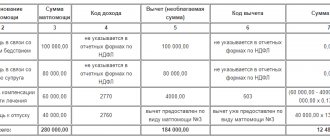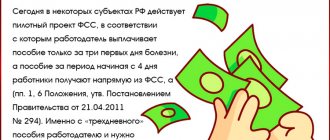Terms and Definitions
The taxation system is a set of tax payments, the obligation to pay which arises from the taxpayer when carrying out business activities.
Moreover, each tax has certain differences; it has an independent object of taxation, which means the sale of goods (work, services), property, profit, income or other circumstance that has a cost, quantitative or physical characteristic.
OSNO is a general (traditional) taxation system in which organizations or businessmen fully calculate and pay taxes.
These include:
- for organizations - profit tax, VAT, property tax;
- for entrepreneurs - personal income tax, VAT.
STS - Simplified Taxation System (STS) - a special tax regime applied to organizations and entrepreneurs; differs from OSNO by replacing the payment of taxes with the payment of a single tax, and at a reduced rate, calculated based on the results of economic activity for the tax period.
Elements of tax - objects of taxation, tax rate, tax base, tax period, calculation procedure and deadlines for tax payment.
USN or OSNO: which is better for LLC
In order to determine which taxation system to choose, in addition to the above, you can take into account the following nuances:
- Not all companies can use the simplified tax system. For example, if an organization plans to have branches (representative offices), it will not be able to apply this taxation system.
- Features of the work such as the presence of economic ties with counterparties - VAT payers, a large number of employees, the possibility of calculating depreciation on relatively new and expensive equipment leased and accepted on the balance sheet (for more information about this option, read the article Leasing (financial lease) agreement - conditions and sample) or purchased will determine the choice in favor of OSN.
In addition, you need to make a trial tax calculation for both cases and compare the results (tax amounts payable).
Reporting and taxes
Organizations using the simplified tax system are exempt from paying income tax, property tax (if it is not valued at cadastral value) and VAT (if import operations are not carried out and the duties of a tax agent do not arise) in accordance with paragraph 2 of Article 346.11 of the Tax Code of the Russian Federation.
Individual entrepreneurs using the simplified tax system do not pay personal income tax, are exempt from property tax (if it is not valued at cadastral value) and VAT (if import operations are not carried out and tax agent responsibilities do not arise).
Consequently, LLCs and individual entrepreneurs who have a simplified tax regime submit reports in a simplified format.
The object of taxation for the simplified tax system and the special tax system is also different. The object of the general regime is profit, which is obtained as a result of the difference between income from activities and all expenses. The procedure for determining the tax base under OSNO is defined in Chapter 25 of the Tax Code of the Russian Federation.
There are two options on the simplified tax system:
- “Income minus expenses” (expenses must be economically justified and documented).
- "Income".
It should also be noted here that simplifiers can recognize income and expenses only on the cash basis. This is stated in Article 346.17 of the Tax Code of the Russian Federation. As for income tax, work on the cash basis does not apply to everyone in accordance with Article 273 of the Tax Code of the Russian Federation.
Anyone who chooses the “Income minus expenses” option should be aware that for this regime there are strict restrictions on expenses that can be recognized as part of determining the tax base.
Conclusion
The simplified tax system is a useful tax optimization tool for individual entrepreneurs and small businesses. The main differences between OSNO and simplified tax system are the number of taxes paid and the procedure for accounting for income and expenses. However, when switching to the simplified tax system, one should not forget about the negative sides of this special regime.
Tax legislation offers companies the opportunity to use the simplified tax system or OSNO. Which regime is more beneficial in terms of minimizing the fiscal burden on business and increasing profits? What taxes must be paid and in what form should I report? Where is it easier to organize accounting and do bookkeeping? It is better to think about these nuances at the stage of opening a company, when you can plan future expenses in advance. Let's look into it in detail.
Tags: balance sheet, accountant, capital, tax, expense, simplified tax system
Simplified taxation system
Payers of the simplified tax system
Those who have switched to a simplified tax system can pay a single tax instead of several. Not everyone has the right to make such a choice. This possibility depends on:
- the nature of the activity declared during registration. Some organizations and entrepreneurs cannot apply simplification. For example, when their activities are related to the activities of pawnshops, insurance or the production of excisable goods;
- on cost and quantitative indicators.
- a complete list of cases in which a company or merchant cannot apply the simplified tax system is established by paragraph 3 of Article 346.12 of the Tax Code of the Russian Federation.
What taxes does the simplified tax system exempt from?
Simplified organizations are exempt from paying:
- property tax. An exception is real estate for which the tax base is the cadastral value;
- income tax;
- VAT. With the exception of transactions under joint activity agreements, trust management of property, as well as under concession agreements and when importing goods, when the duties of a tax agent arise;
- All other taxes, fees and insurance contributions are calculated and paid by the organization on the simplified tax system on a general basis.
Entrepreneurs on the simplified tax system differ from OSNO in that they are exempt from paying:
- Personal income tax on income from business activities (except for dividends and income subject to personal income tax at rates of 35 and 9 percent);
- tax on property of individuals used in business activities. An exception is real estate for which the tax base is the cadastral value;
- VAT. With the exception of transactions under joint activity agreements, trust management of property, as well as under concession agreements and when importing goods and when the duties of a tax agent arise.
Selecting an object of taxation according to the simplified tax system
The object of taxation according to the simplified tax system is “Income” or “Income minus expenses”.
In the first case, the business entity generally applies a rate of 6 percent (unless another reduced rate is established by regional legislation), in the second case - 15 percent. By the way, choosing an object under the simplified tax system is also an element of tax planning. The right to think about the choice is granted to both newly registered organizations and businessmen, and to existing entities. Tax legislation allows you to change the object once a year.
Many experts point out that the determining criterion for choosing an object of taxation is the profitability of the products (works, services) produced. Moreover, this indicator is planned.
So, if the profitability according to the business plan is above 40 percent, then the “Income” object with a rate of 6 percent is more profitable. If profitability is lower, then the “Income minus expenses” object with a rate of 15 percent is more profitable.
In numbers. Example of choosing a taxable object
When registering, the owner of Alpha LLC selects an object under the simplified tax system, using the following information on the proposed activities according to the business plan:
- type of activity - consumer services for the population;
- estimated income - 4,250,000 rubles;
- the estimated amount of expenses taken into account under the simplified tax system is 2,700,00 rubles (including 1,250,000 rubles for payments in favor of individuals and contributions);
- profit from sales (financial indicator) - 1,200,000 rubles.
- profitability indicator - 44%.
Let's assume that in 2021 society will be able to use the aggregate rate for insurance contributions to extra-budgetary funds - 30%. The contribution rate to the Social Insurance Fund in case of injury is 0.3%.
Calculation of indicators for choosing a tax system
First, we will determine the amount of insurance contributions to extra-budgetary funds that the society will have to pay. Let's assume that all payments are subject to contributions. Then the amount of contributions will be 375,000 rubles (1,250,000 rubles × 30%), and for insurance in case of injury - 3,750 rubles (1,250,000 rubles × 0.3%).
Object - “Revenue”
The tax amount is 255,000 rubles (4,250,000 rubles × 6%). In this case, the tax payable can be reduced by the transferred insurance premiums. The total amount of contributions is 378,750 rubles (375,000 rubles + 3,750 rubles). This is more than half the tax. Therefore, the tax can be reduced only by 50%, and the amount payable will be 127,500 rubles (255,000 rubles × 50%).
Object - “Income minus expenses”
The tax base will be 1,550,000 rubles (4,250,000 rubles – 2,700,000 rubles). The tax amount at a rate of 15% is equal to 232,500 rubles (1,550,000 rubles × 15%).
Let's compare the results: 127,500 rubles < 232,500 rubles. For society, the simplified tax system with the object “Income” is preferable, as indicated by the profitability indicator.
Advantages of using the simplified tax system
- Low tax burden.
- Possibility of changing the object of taxation.
- Tax reporting is submitted in a reduced quantity.
- Possibility of applying tax holidays for entrepreneurs.
Disadvantages of using the simplified tax system
- The likelihood of switching to OSNO if the profitability threshold or the number of employees is exceeded.
- A limited list of expenses taken into account under the object of taxation “Income minus expenses”.
Transition from OSN to simplified tax system
Art. 346.12 of the Tax Code of the Russian Federation provides for the possibility of switching to the simplified tax system if the following conditions are met:
- The amount of income for 9 months of the year in which the notice of transition to the simplified tax system is submitted does not exceed 112.5 million rubles. (this rule applies only to organizations; the income of an individual entrepreneur can be any).
- The average number of employees is no more than 100 people.
To learn how to determine the average number of employees, read the material “How to calculate the average number of employees?”.
- The residual value of fixed assets as of October 1 of the year in which the organization declares its right to use the simplified tax system is no more than 150 million rubles.
IMPORTANT! For the purposes of transition to the simplified tax system, only organizations must comply with the fixed value limit. For individual entrepreneurs, this criterion does not apply at the stage of submitting an application to the simplified tax system. But entrepreneurs must comply with it while working on a simplified basis.
Read about what property is depreciable and how to account for it in this material.
- The share of participation of other organizations in the authorized capital of the enterprise is no more than 25% at the time of application. Exceptions are specified in subsection. 14 clause 3 art. 346.12 Tax Code of the Russian Federation.
- The taxpayer does not belong to the other categories of persons specified in paragraph 3 of Art. 346.12 Tax Code of the Russian Federation.
To switch to the simplified tax system, you must submit a notification to the Federal Tax Service at the place of registration before December 31 of the year preceding the transition, or within 30 days from the date of registration, if the notification is submitted by a newly created legal entity or individual entrepreneur.
IMPORTANT! When December 31 is a holiday, the deadline for submitting a notice of transition to the simplified tax system is shifted to the next working day, that is, to the first working day of January. The deadline for submitting a notice of transition to the simplified tax system from 2021 is exactly 12/31/2020, since it is a working Thursday.
A taxpayer can return to OSNO only from the next tax period, except in cases where:
- the amount of income for the reporting period exceeded 150 million rubles.
For more information about the income limit, see the material “Income limit when applying the simplified tax system .
- the taxpayer ceased to meet the requirements established by paragraphs. 3 and 4 tbsp. 316.12 and paragraph 3 of Art. 346.14 Tax Code of the Russian Federation.
When switching from the OSN to the simplified tax system, restore the VAT on the inventories and advances issued as of December 31.
If you don’t know how to do this correctly, use the recommendations from ConsultantPlus. Get trial access and access expert explanations and calculations for free.
BASIC
As mentioned above, OSNO differs from the simplified tax system in the payment of taxes on activities. These include for organizations:
- income tax. The object of taxation is the profit of the organization. This indicator is calculated as the difference between the organization's income and expenses. The rate is 20%. Tax period - calendar year;
- VAT. The object of taxation is the sale of goods (works, services) and property rights. The rate is 20% (there are also rates of 10% and 0% on certain categories of goods).
- organization property tax. Object of taxation: property that is recorded in accounts 01 “Fixed assets” and 03 “Income-generating investments in tangible assets”; The tax is calculated only on real estate at rates established by the regions of the Russian Federation.
The tax rate depends on the selected value of the property: balance sheet or cadastral. The general rate is 2.2%, but it may vary depending on the region.
Application of UTII
If a taxpayer already combines the use of UTII and OSNO, he has the right to switch to the simplified tax system for those types of activities for which he does not apply imputation. But to determine the possibility of switching to the simplified tax system it is necessary:
- calculate the average number of employees and the residual value of fixed assets as of October 1 of the year in which the notice of transition is submitted, separately for types of activities related to UTII and OSNO;
- determine the maximum income for activities on OSNO without taking into account income from activities on UTII.
If the UTII payer decided to switch to the simplified tax system, then he can do this only from the next tax period, except for the case when the UTII was applied in parallel with the simplified tax system (letter of the Ministry of Finance of the Russian Federation dated November 24, 2014 No. 03-11-09/59636). When switching from UTII to the simplified tax system, you should check for compliance with existing limits the indicators of income, the residual value of fixed assets and the average number of employees after combining data on UTII and the simplified tax system.
NOTE! The UTII taxation regime will be abolished from 2021. See here for details.
When is it better to pay more taxes but stay on OSNO
Working with partners with VAT
Organizations that pay value added tax choose first of all similar partners (VAT payers).
This is done because the VAT paid can be deducted. Therefore, if at the moment there are many such partners, then it is better to continue working for OSNO.
Purchasing goods in another country
The law establishes that all firms that import are required to pay VAT. The difference is that on OSNO the VAT paid can be deducted (as in the first case). Deduction allows you to reduce costs.
Eligibility for income tax benefits
Some categories of organizations have tax benefits:
- organizations from the field of medicine and education;
- agricultural enterprises;
- social service organizations;
- participants of special economic zones.
If you belong to one of these categories, then it is better to stay on OSNO. The difference in tax burden will be in your favor.
Who can work under the simplified tax system
The prevalence of “simplified” can be explained by the fact that it is acceptable for use by those representatives of the sphere of medium and small businesses who are engaged in providing a certain, and quite wide, range of services and work in relation to the population, as well as other individual entrepreneurs and legal entities. But there are also exceptions. For example, according to the simplified tax system the following are not allowed to work:
- Non-state insurance and pension funds;
- Those companies whose main activity is organizing and conducting gambling, etc.;
- Companies engaged in the extraction and sale of mineral resources;
- Lawyers, notaries;
- Foreign organizations;
- Any financial structures: investment funds, banks, pawnshops, microfinance organizations, etc.;
- Some other business representatives;
- A more complete list is presented here.
This list undergoes periodic changes, so if necessary, it can be clarified by the tax service.





